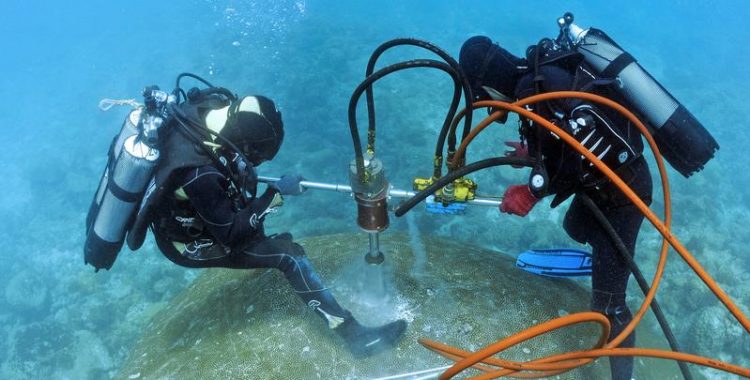Ocean acidification: Coral core reveals dropping pH values in South Pacific

Taking the core from a coral in the South Pacific. Photo: John Butscher, IRD-Centre de Noumea, New Caledonia
Burning of fossil fuels, deforestation of tropical rain forests and mangroves are only some of the man-made causes leading to an increase of carbon dioxide (CO2) in the Earth's atmosphere. Oceans are functioning as sinks for CO2 and absorb more than 40% of anthropogenic greenhouse gases.
When CO2 from the atmosphere reacts with seawater to form carbon dioxide, the water’s pH value decreases and so-called ocean acidification occurs. This process affects calcifying organisms such as corals, mussels or some plankton species and can disturb their ability to build a fully functional calcareous skeleton. Until recently, reliable long-term measurements and historical data to illustrate the influence of CO2 uptake on the pH value of the seas have been insufficient.
A team of French scientists and climate researcher Dr. Henry Wu, who works at the Leibniz Centre for Tropical Marine Research (ZMT), have now used a coral core to show how the pH value in the South Pacific has changed since pre-industrial times. The study was just published in the journal “Nature Communications”.
Stony corals can live for several hundred years. They grow between a few millimetres and several centimetres per year and form growth rings like trees. Their calcareous skeleton is considered a natural archive in which information about the chemistry of seawater is stored in very high resolution. Depending on the environmental conditions, corals incorporate different amounts of trace elements into their skeleton.
The research team took the core from a compact hard coral of the genus Diploastrea in the South Pacific. “Like cores from the ice of the polar ice caps, coral cores offer us a glimpse into the climate history of the marine region from which they were taken and allow us to make statements about the future,” says Henry Wu.
Samples from the growth rings of the coral core were examined by Henry Wu for boron and other elements such as oxygen. Boron is a natural component of seawater and its isotopes are sensitive to changes in ocean pH. In addition, oxygen isotopes provide information about the temperature of the water.
The measurements provided a much differentiated picture of natural variations and the evolution of pH and surface water temperature in the South Pacific since 1689 to the present day. Together with Dr. Delphine Dissard and other project partners of the Institut de Recherche pour le Développement and the Centre National de la Recherche Scientifique in France, Henry Wu was able to prove that under the influence of the Industrial Revolution at the end of the 19th Century the pH value began to decrease by 0.12.
The team also found evidence of a correlation with climate anomalies such as El Niño, which occur regularly in this marine region. During this phenomenon, the trade winds and ocean currents in the Pacific change direction and cause considerable temperature changes. The event also influences the pH value, as warmer water absorbs less CO2 than cold water.
“It is important to grasp this variability,” explains Henry Wu. “This is the only way to distinguish natural fluctuations in pH from those caused by CO2 emissions.”
Henry Wu's ideas for an expansion of the project have since been financially supported within the framework of the research initiative “Make Our Planet Great Again”, which is funded by the DAAD and the Federal Ministry of Education and Research. During the five-year project, which is being financed with one million Euros, the development of pH and temperature values and carbonate chemistry since the Industrial Revolution in various regions of the Atlantic, Pacific and Indian Ocean will be investigated.
Publication
Wu, H. C., D. Dissard, E. Douville, D. Blamart, L. Bordier, A. Tribollet, F. Le Cornec, E. Pons-Branchu, A. Dapoigny, and C. Lazareth (2018), Surface ocean pH variations since 1689 CE and recent ocean acidification in the tropical South Pacific. Nature Communications, doi: 10.1038/s41467-018-04922-1. Open access.
Contact
Dr. Henry Wu
Leibniz Centre for Tropical Marine Research
Phone: 0421 / 23800-178
Mail: henry.wu@leibniz-zmt.de
Media Contact
More Information:
http://www.leibniz-zmt.deAll latest news from the category: Earth Sciences
Earth Sciences (also referred to as Geosciences), which deals with basic issues surrounding our planet, plays a vital role in the area of energy and raw materials supply.
Earth Sciences comprises subjects such as geology, geography, geological informatics, paleontology, mineralogy, petrography, crystallography, geophysics, geodesy, glaciology, cartography, photogrammetry, meteorology and seismology, early-warning systems, earthquake research and polar research.
Newest articles

First-of-its-kind study uses remote sensing to monitor plastic debris in rivers and lakes
Remote sensing creates a cost-effective solution to monitoring plastic pollution. A first-of-its-kind study from researchers at the University of Minnesota Twin Cities shows how remote sensing can help monitor and…

Laser-based artificial neuron mimics nerve cell functions at lightning speed
With a processing speed a billion times faster than nature, chip-based laser neuron could help advance AI tasks such as pattern recognition and sequence prediction. Researchers have developed a laser-based…

Optimising the processing of plastic waste
Just one look in the yellow bin reveals a colourful jumble of different types of plastic. However, the purer and more uniform plastic waste is, the easier it is to…



